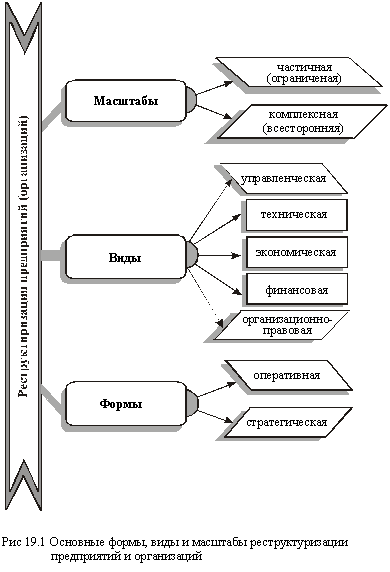home
 Economy Economy
 Business Economics - Pokropivny SF Business Economics - Pokropivny SF
|
Business Economics - Pokropivny SF
CHAPTER 19. Restructuring and sanitation (financial rehabilitation) of enterprises and organizations
Key concepts and terms
The structure of production; restructuring of enterprises (organizations), forms and types of restructuring; stages (order) of restructuring; options for restructuring; reorganization of business entities; model of the process of financial recovery; rehabilitation project; business plan for financial recovery; a feasibility study for rehabilitation
19.1 General characteristics protsessarestrukturizatsii enterprises (organizations)
Necessity, essence and purpose of restructuring
The stabilization of the domestic economy and the gradual increase of the economic potential of the country is directly linked to the implementation of an active structural policy - a key element of the overall strategy for the development of primary units (enterprises and organizations) and social production as a whole.
The current state of the economy at the macro and micro level is characterized by the production of the deformed structure. Therefore, one of the strategic objectives of more effective development of productive capacities is its restructuring. The latter can be achieved, on the one hand, with the help of an effective policy of restructuring and rehabilitation of potentially competitive enterprises, and on the other - by the elimination (complete conversion) unprofitable and bankrupt enterprises.
The restructuring process can be considered as a way of removing the contradictions between the demands of the market and the outdated logic of the enterprise activities. In fact, the restructuring of the company - is the realization of organizational, economic, legal and technical measures aimed at: changes in the company structure, management, ownership, organizational and legal forms; financial recovery, increasing production of competitive products, increase production efficiency.
The aim of the restructuring is to create a full-fledged business entities able to operate effectively in a market economy and to produce competitive products that meet the requirements of the commodity markets. Therefore, the restructuring process can be defined as a set of measures aimed at restoring a sustainable technical, economic and financial life of enterprises.
Forms and types of restructuring
Enterprise Restructuring usually involves two main objectives: firstly, to ensure its survival in the near future; secondly, to restore its competitiveness in the long term. In line with these objectives and will allocate these types of restructuring of enterprises and organizations (Fig. 19.1).

- In the process of operational restructuring of the enterprise (organization) focuses on solving major problems: 1) providing liquidity and 2) a significant improvement in the results of his (her) activities. This restructuring takes place, usually within 3-4 months and involves a sharp increase in the efficiency of private enterprise. The latter is achieved through a set of operational measures presented (Fig. 19.2).

However, if the enterprise transformation process (organization) only limited operational restructuring, it (she) will soon inevitably again be in a state of crisis.
- The strategic restructuring of the company aimed at ensuring long-term competitiveness in the domestic and global markets. To achieve this it is necessary to clearly define the strategic goal of the restructuring of the enterprise (organization). Fully justify the purpose of the restructuring of a particular business entity can be formulated in general terms as follows: The company's products and the result of the organization must comply with the current effective demand in the market. The company, which satisfies this requirement, on the one hand retains centralized control in the most important spheres of activity, on the other hand - is reborn thanks to an active scientific, technical and market strategy within the product group. As a rule, the state of crisis of the enterprise comes as a result of not one but several reasons. The more of them there, the slower the reaction becomes entities to change the type of economic system.
- Organizational and legal form of restructuring involves the commercialization and corporatization of operations, changes in the organizational structure of a business entity, the change of ownership of state-owned enterprise (the institution).
- Management restructuring linked to the training and retraining of personnel with a focus on the competitive operation of the enterprise, the modern marketing, technical innovation and its policy.
- Technical restructuring is intended to provide a s such a state enterprise, in which it reaches the appropriate level of production capacity, technology "know-how" of managerial skills, staff, efficient systems of supply and logistics, t. E. All that allows the entity to go on the market with an efficient competitive products.
- Economic restructuring is to provide a level of profitability of production (activity), which corresponds to the current economic conditions. It requires a certain level of operating and capital costs, flexible pricing and a sufficient amount of the sale of goods.
- Financial restructuring is the formation of a balance sheet structure, in which the liquidity and solvency meets the requirements of the market, and there are no problems with repayment of loans, other debt instruments and the payment of interest on them.
The essence and content of the necessary restructuring of the enterprise depends on the nature of the problems. Sometimes a company needs only a partial or limited restructuring of the so-called for the restoration of economic and technical viability. At the same time, the company set for itself certain standards (guidelines), which are the ultimate goal of the implementation of the reform of the relevant type. These guidelines may be the level of financial liveridzha (the ratio of debt and equity), the size of the enterprise working capital and debt coverage ratio.
To achieve the set values can be used such measures as restructuring (re-registration) of debt, additional issue of securities, revaluation of assets, liquidation, collection, accounts receivable and so on. N. When the enterprise problems are more significant, then it must implement the so-called comprehensive restructuring . It is quite obvious that this type includes reforming and financial restructuring.
A comprehensive restructuring includes the development of the organizational structure corresponding to product, labor, technical and technological policies, changes in management, organization of the company, and so on. N. Such a profound restructuring of the company or other business structure lasts in most cases up to three years.
During the study species, forms and degrees of restructuring of a business entity is first necessary to deeply analyze its feasibility and financial position. The first question that you need to find the answer - is to determine the type of product that will produce the company after the restructuring in order to restore its capacity and normal operation.
This must be preceded by an analysis of all areas on the criterion of competitiveness of production of the company (price, quality), market share, cost structure and profitability. Above all such alternatives analyzed:
- .. If the profitability of the production of certain products can not be recovered due to the low quality of these products obsolete technology, high cost, low capacity utilization, which makes it impossible to provide an expected saving of resources in connection with the increase in the scale of production, etc., the production must be stopped;
- to release resources (capacities, "know-how" management and labor potential) determined promising new products, the production of which will provide the necessary return on invested capital, taking into account the restructuring costs;
- if production can not be restored even if the restructuring of the technical base and re-staff, then the company is to be closed, and wasteful and outdated equipment and cash assets should be sold (realized), and the production area leased.
In the process of restructuring its implementation strategy should be to strengthen activities in three main areas:
- reduce costs and increase efficiency and productivity, reduction of energy intensity of production, the strengthening of control over the quality of products;
- introduction of new technology, the appropriateness of which must be carefully justified;
- upgrading or replacement of equipment in most cases advantageous to replace modernization criterion of costs and in terms of the company's development strategy.


Comments
Commenting, keep in mind that the content and the tone of your messages can hurt the feelings of real people, show respect and tolerance to his interlocutors, even if you do not share their opinion, your behavior in terms of freedom of speech and anonymity offered by the Internet, is changing not only virtual, but real world. All comments are hidden from the index, spam control.